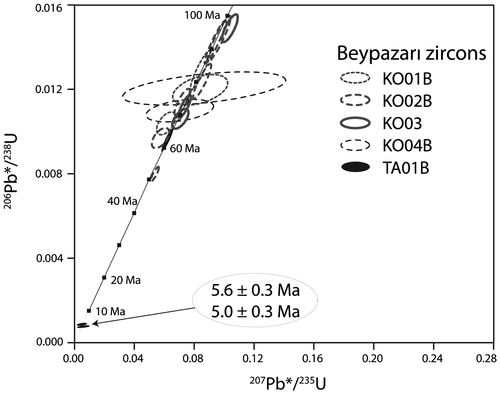Abstract
The Beypazarı granitoid is emplaced in a Late Cretaceous volcanic arc in north central Turkey and provides evidence for processes that occurred during the closure of the Neo-Tethys Ocean. Zircons from its northern granodiorite and quartz monzonite exposure are dated in rock thin section and display characteristic igneous zoning in cathodoluminescence (CL). Its oldest Late Cretaceous ages (95.4 ± 4.2–91.3 ± 6.5 Ma, 238U/206Pb, ±1σ) time early crystallization from rising melts, but inspection of the youngest grains in composite CL–secondary electron images shows they are located along grain boundaries surrounded by alteration textures and were possibly affected by fluid-driven metamorphism. Ages obtained from zircon mid-rims (82.7 ± 6.0–70.5 ± 3.4 Ma) record continuous crystallization of the pluton. Here, we model the Late Cretaceous development of the Beypazarı granitoid wherein subduction of Neo-Tethys Oceanic plate, multiple injections and mixing of magma, and crustal contribution during ascent are the cause of geochemical heterogeneities within the pluton and account for protracted zircon crystallization. The model speculates that the pluton is in the overriding tectonic plate of a series of stacked, north-dipping subduction zones that record the closure of Neo-Tethys ocean basins during the geologic assembly of Turkey.
1. Introduction
Turkey is an east/west-trending mosaic of continental fragments that consolidated to form parts of the Alpine–Himalayan orogenic belt (Göncüoğlu et al., Citation2000). The Beypazarı granitoid (Figures and ) represents the crystallized remnant of a Late Cretaceous magma chamber (e.g. Billur, Citation2004) and is a key recorder of the geologic assembly of Turkey. The pluton is located north of the İzmir-Ankara-Erzincan Suture Zone (İAESZ) and provides evidence for subduction of the Neo-Tethys Ocean beneath the overriding continental lithosphere of the Sakarya Zone (Billur, Citation2004; Şengör & Yılmaz, Citation1981; Yücel Öztürk, Helvacı, & Satır, Citation2012). The high pressure/low temperature (HP/LT) Tavşanlı Zone is south of the İAESZ and represents the northern front of the Anatolide–Tauride Block (Okay et al., Citation1996; Okay & Tüysüz, Citation1999). Dehydration of the subducting Tavşanlı slab induces the source melts that give rise to the Beypazarı granitoid (Billur, Citation2004; Kadıoğlu & Zoroğlu, Citation2008).
Figure 1. Simplified map of major structures and locations of plutons in western Turkey (Okay, Citation2008; Şenel & Aydal, Citation2000). The Beypazarı and Sivrihisar plutons are shown in the black box. The GAC is north of Beypazarı (Keller et al., Citation1992).
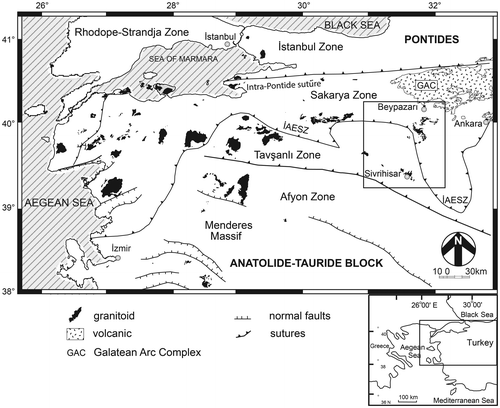
Figure 2. Simplified geologic map of the Beypazarı and Sivrihisar plutons (Özsayin & Dirik, Citation2007; Şenel & Aydal, Citation2000).
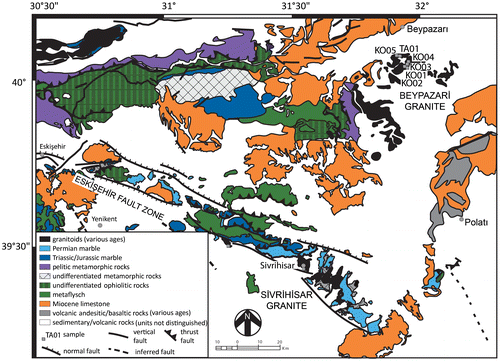
Like other plutons in the Tavşanlı Zone, the Sivrihisar granitoid (Figure ) intruded the HP/LT assemblages of the subduction zone footwall rather than the hanging wall of the Sakarya Zone. The possible mechanisms for intrusions into the Tavşanlı Zone are the subject of numerous studies (Altunkaynak, Citation2007; Altunkaynak & Dilek, Citation2013; Dilek & Altunkaynak, Citation2009; Okay, Harris & Kelley, Citation1998; Okay & Satır, Citation2006; Shin, Catlos, Jacob & Black, Citation2013; Ustaömer, Ustaömer, Collins & Reischpeitsch, Citation2009). To the south of the Tavşanlı Zone, HP/LT metamorphism is also observed in the Afyon Zone which may be the missing link between the granitoids and their tectonic associations (Candan, Çetinkaplan, Oberhänsli, Rimmelé, & Akal, Citation2005; Okay et al., Citation1998; Okay & Satır, Citation2006; Shin et al., Citation2013). Understanding the relationship between granitoids on both sides of the İAESZ is crucial for accurate reconstructions of the tectonic history of Turkey.
This study provides new insights from major and trace-element geochemistry, in situ (in thin section) U–Pb ion microprobe zircon geochronology and cathodoluminescence (CL) imagery of the Beypazarı granitoid. Here, we explore these basic questions: (1) When did the granitoid crystallize? (2) In what tectonic environment and from what source rocks did the pluton form? and (3) What are its regional relationships to other tectonic elements in the area, including other plutons and a major arc complex? The results have implications for our understanding of the consolidation of Turkey and the utility of zircon as a geochronometer in magmatic assemblages.
2. Previous studies
The Beypazarı granitoid (Figures –) is exposed in a ~200 km2 area of north central Turkey, ~75 km northwest of the capital city of Ankara. Although outcrops are not continuous at the surface, aeromagnetic anomaly mapping suggests that they belong to a single structure at depth (Kadıoğlu & Zoroğlu, Citation2008). Major and trace-element geochemical data from previous studies indicate that the Beypazarı pluton is a calc-alkaline, metaluminous, I-type volcanic arc granitoid (Billur, Citation2004; Delaloye & Bingöl, Citation2000; Diker, Çelik & Kadıoğlu, Citation2006; Helvacı & Bozkurt, Citation1994; Yücel Öztürk et al., Citation2012). Based on stable and radiogenic isotopes of the whole rock and silicate minerals, the Beypazarı pluton has a significant crustal component, possibly from anatexis of lower crustal alkaline mafic assemblages (Yücel Öztürk et al., Citation2012). Previous reports of initial 87Sr/86Sr ratios ranging from .70529 to .70704 are interpreted as a continental crustal component in the melt, and are consistent with values of hybrid Turkish rocks (Helvacı & Bozkurt, Citation1994; Yücel Öztürk et al., Citation2012).
Figure 3. Field photographs showing locations of (a) sample KO04B and outlines of mafic enclaves, and (b) aplite dike (black line) where sample KO01A was collected.
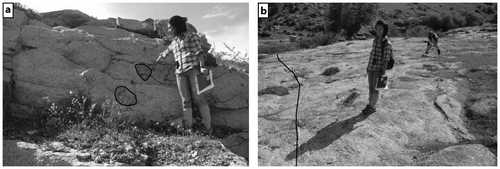
The inner exposure is composed of light-grey and pink granite and granodiorite with quartz, plagioclase, orthoclase, amphibole, and accessory titanite, epidote, zircon, apatite, biotite and opaque minerals (Billur, Citation2004; Helvacı & Bozkurt, Citation1994; Kadıoğlu & Zoroğlu, Citation2008; Yücel Öztürk et al., Citation2012; Zoroğlu & Kadıoğlu, Citation2003). Although the pluton has been mapped into two major units: granodiorite and diorite (Yücel Öztürk et al., Citation2012), other lithologies are found along the outer rim. Here, granodiorite is in gradational contact with quartz monzonite and monzonite (Billur, Citation2004; Kadıoğlu & Zoroğlu, Citation2008) and amphibole minerals increase toward the rim (Zoroğlu & Kadıoğlu, Citation2003). Sharp contacts with metamorphic country rocks (phyllite, schist, marble) are marked by 3–10 m thick hornfels assemblages (Helvacı & Bozkurt, Citation1994). The granitoid contains fine-grained, elliptical mafic enclaves up to 1 m in long dimension and composed of hornblende, plagioclase and pyroxene, with minor titanite and secondary chlorite (Figure (a)) (Billur, Citation2004; Kadıoğlu & Zoroğlu, Citation2008). The enclaves lack both reverse plagioclase zoning and foliated or granoblastic textures associated with xenocrystic enclaves; rather, they include acicular apatite and poikilitic feldspar megacrysts consistent with magma mixing (Billur, Citation2004; Kadıoğlu & Zoroğlu, Citation2008; Zoroğlu & Kadıoğlu, Citation2003).
The pluton is transected by aplite dikes comprised of K-feldspar and quartz with minor hornblende, biotite, opaque minerals, apatite and zircon (Figure (b)) (Billur, Citation2004). These typically trend NE-SW and NW-SE and range in thickness from a few cm to 3 m. The dikes formed in joints that may have developed during contraction as the pluton cooled and show evidence of pronounced alteration (Billur, Citation2004; Helvacı & Bozkurt, Citation1994).
Structural relationships constrain the age of the Beypazarı granitoid (Billur, Citation2004). The pluton is younger than the Triassic Tepeköy metamorphic unit into which it intruded and older than the Paleocene–Eocene deposits located unconformably above it (Göncüoğlu et al., Citation2000; Okay et al., Citation1996; Sayıt & Göncüoğlu, Citation2013; Yağmurlu & Helvacı, Citation1994). K-Ar hornblende ages are Late Cretaceous (82.9 ± 1.8, 79.4 ± 4.4, 77.7 ± 4.5 Ma) (Delaloye & Bingöl, Citation2000). Low radiogenic Ar is reported for these ages (37–74%), and the sample locations are not published. K-Ar hornblende ages reported for volcanic rocks in the nearby Galatean Arc Complex (GAC) (Figure ) are 76.4 ± 2.4 Ma (Koçyiğit, Winchester, Bozkurt & Holland, Citation2003) and 73.2 ± 1.2 Ma (Keller, Jung, Eckhardt & Kreuzer, Citation1992).
3. Methods
Samples were collected during two field seasons (TA#, KO#) and petrographically characterized using a regular light microscope for their mineralogy and textures (Figure , Table ). Rock chips from the granitoid (TA01A, KO01B, KO02B, KO03, KO04A, KO04B and KO05) and an aplite dike (TA01B) were sent to Activation Laboratories in Ontario, Canada, for bulk element geochemical analyses (Tables and , and Figures and ). Whole-rock fusion inductively coupled plasma (ICP) methods were used to identify the major oxides (wt.%) and elements Sc, Be, V, Ba, Sr, Y and Zr (in ppm). Trace elements representing less than .1 wt.% of the sample were found using fusion ICP/mass spectrometry (in ppm).
Table 1. Geographic coordinates and mineral assemblages of samples in this study.
Table 2. Bulk major-element concentrations from the Beypazarı granitoid.
Table 3. Bulk trace-element concentrations from the Beypazarı granitoid.
Figure 4. (a) Total alkali vs. silica diagram (Middlemost, Citation1994) for the Beypazarı granitoid. (b) Fe* = FeOtot/(FeOtot + MgO) vs. SiO2 wt.%. (c) Modified Alkali-Lime Index. MALI = Na2O + K2O – CaO vs. SiO2 wt.%. (d) Aluminum Saturation Index. ASI = Al/Ca – 1.67P + Na + K (molar) vs. SiO2 wt.%. Scheme in (b) through (d) after Frost et al. (Citation2001). Data from Helvacı & Bozkurt (Citation1994) n = 24; Delaloye & Bingöl (Citation2000) n = 3; Billur (Citation2004) n = 12; Diker et al. (Citation2006) n = 8; Yücel Öztürk et al. (Citation2012) n = 11; this study, n = 8. Results from this study are shown in black; previous studies are in grey.

Figure 5. (a) K2O vs. SiO2 wt.%, after Peccerillo & Taylor (Citation1976). (b) Rb vs. (Y + Nb) (in ppm) tectonic discrimination diagram showing fields for syn-collisional (Syn-COLG), within-plate (WPG), volcanic arc (VAG) and ocean ridge (ORG) granitoids (Pearce et al., Citation1984). Data in (a) and (b) from the same sources as Figure . c Chondrite-normalized (Sun & McDonough, Citation1989) rare earth element (REE) patterns and d multi-element diagram for the Beypazarı granitoid. Shaded areas define previously reported compositions from Billur (Citation2004).
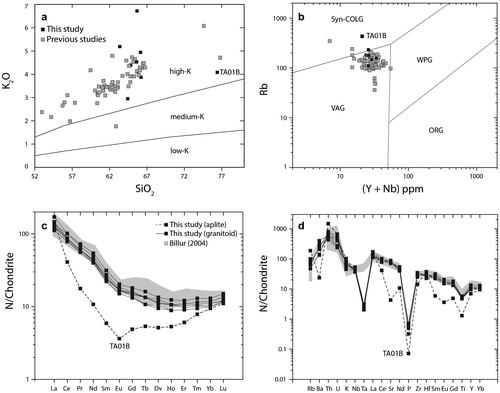
Zircons were located in polished 30-μm thin sections using an optical petrographic microscope, and documented following the methods outlined by Catlos, Gilley & Harrison (Citation2002). In situ analyses on 18 zircons from five samples (KO01B, KO02B, KO03, KO04B and TA01B) produced 22 ages (Tables and , and Figure ) using the CAMECA ims1270 ion microprobe at UCLA. An aperture window was used to minimize common Pb contamination from outside the boundaries of the ion microprobe spot. Analytical details are located in Appendix 1.
Table 4. Ion microprobe 238U/206Pb zircon data from the Beypazarı granitoid rocks.
Table 5. Ion microprobe 238U/206Pb zircon data for the aplite dike.
To assist in the interpretation of the ages, cathodoluminescence (CL) and secondary electron (SE) images of dated zircons and thin sections were produced using the FEI Nova NanoSEM 430 field emission scanning electron microscope (SEM) with attached Gatan ChromaCL system at UT Austin’s Bureau of Economic Geology (Figures through ). The electron beam operated at 10 and 15 kV for zircons and thin sections, respectively. Both analyses used a current of 7.6 nA, ~12 mm working distance and 5-min exposure time. Minerals associated with color were determined with energy-dispersive spectroscopy (EDS). Composite CL–SE images were prepared using the National Institutes of Health program ImageJ.
Figure 7. CL images of dated (a) zircon 4 in sample KO03, (b) zircon 2 in sample KO02B and (c) zircon 5 in sample KO02B. Dashed white ovals in these panels outline the location of the ion microprobe spot and the solid line outlines the zircon grain. Dashed white boxes outline the aperture window. Two ages were obtained from zircon 2. (d), (e) and (f) are SE images of the dated zircons showing the elliptical depression made by the ion microprobe. Interpreted inner core, mid-rim and outer rim are outlined in white. Truncation surfaces are indicated by dashed curves. (g), (h) and (i) are composite CL–SE images of the zircons in thin section. FeO: iron oxide and CRK: crack; other mineral abbreviations after Kretz (Citation1983).
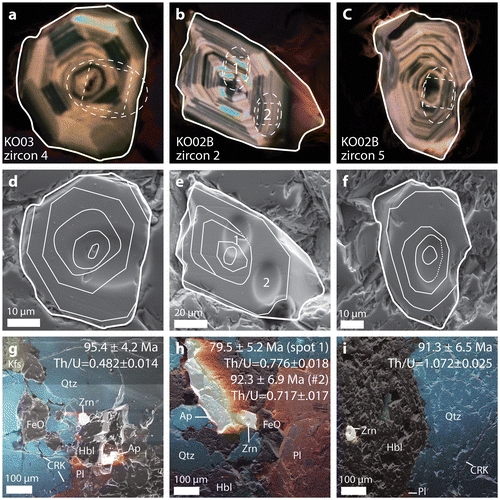
4. Results
4.1. Geochemistry
Geochemical results are plotted in a series of diagrams (Figures and ) to aid in interpretation of tectonic setting, magma sources and subsequent modification during transport and shallow crustal storage. Results from five previous studies of the pluton (Billur, Citation2004; Diker et al., Citation2006; Helvacı & Bozkurt, Citation1994; Delaloye & Bingöl, Citation2000; Yücel Öztürk et al., Citation2012) are included in selected diagrams. Two studies (Delaloye & Bingöl, Citation2000; Helvacı & Bozkurt, Citation1994) do not indicate the locations of their samples; therefore, the relationship of their geochemical data to ours is unclear. Some samples (Billur, Citation2004) are located in the northwestern pluton, whereas others (Diker et al., Citation2006) were collected from the geothermal springs region of the pluton ~20 km to the southwest. Three of the samples from Yücel Öztürk et al. (Citation2012) were collected from the northern exposure and have geochemical characteristics similar to ours.
The total alkali vs. silica diagram (Figure (a)) (Middlemost, Citation1994; Rollinson, Citation1993) classifies the samples in this study as granodiorite and quartz monzonite, with the exception of one granite sample (TA01B) from the aplite dike. Data from the previous studies included on the diagram are gabbroic diorite, diorite, granodiorite, monzodiorite, monzonite, quartz monzonite, granite, and one sample of syenitic composition. The pluton ranges from ~53 to 77 wt.% SiO2.
The three-tiered classification system (Figure (b) through (d)) for granitic rocks compares major-element variables to increasing SiO2 (wt.%) (Frost et al., Citation2001; Frost & Frost, Citation2008). Figure (b) distinguishes among ferroan and magnesian granitoids, where assemblages with higher Fe/(Fe + Mg) ratios are speculated to crystallize from anhydrous melts in reducing chemical environments, and Fe depletion in magnesian rocks may result from crystallization of magnetite under oxidizing conditions (Frost et al., Citation2001; Frost & Frost, Citation2008). Ferroan granitoids may also be produced by a variety of processes such as differentiation of an iron-rich mafic magma or dehydration melting of calc-alkaline magnesian granitoids at low pressures, although a combination of processes is more likely (Bogaerts, Scaillet & Auwera, Citation2006; Frost & Frost, Citation2011). Variables such as melt composition, pressure, temperature, H2O content and fO2 contribute to the composition of the mineral assemblage (Frost & Frost, Citation2011). Although the majority of data from previous studies plot in the magnesian field with Fe* < .78, all samples of this study and five from previous reports are ferroan with Fe* between .78 and .95 (Billur, Citation2004; Delaloye & Bingöl, Citation2000; Helvacı & Bozkurt, Citation1994).
Based on the Modified Alkali-Lime Index (MALI) (Figure (c)), six samples in this study are calc-alkalic, one is alkali-calcic, and one plots on the boundary between alkali-calcic and alkalic. Samples from previous studies are calc-alkalic and calcic, with some exceptions (Billur, Citation2004; Helvacı & Bozkurt, Citation1994). The Aluminum Saturation Index (ASI = Al/(Ca–1.67P + Na + K molar) (Figure (d)) distinguishes metaluminous (ASI < 1) from peraluminous rocks (ASI > 1). Samples in this study are metaluminous (.785–.974), with the exception of sample TA01B which is peraluminous (1.008). Most samples from previous studies are metaluminous, but four are peraluminous (1.077–1.114) (Helvacı & Bozkurt, Citation1994). Chappell & White (Citation1974) classify granitoids with ASI < 1.1 as I-type, where ASI = Al/(Na + K + Ca) molar. This variation produces similar ASI values for the granitoid (.777–1.111) and the aplite (1.006). The presence of hornblende, titanite and apatite is also indicative of I-type granitoids (Chappell & White, Citation1974).
The K2O vs. SiO2 diagram (Peccerillo & Taylor, Citation1976) (Figure (a)) shows that, with the exception of one sample (Helvacı & Bozkurt, Citation1994), the Beypazarı compositions plot in the high-K field, similar to many plutons in active continental margins (Rollinson, Citation1993). Other variation diagrams indicate that Rb correlates positively, whereas Fe2O3, MgO, CaO and TiO2 correlate negatively with increasing SiO2 wt.% (not shown), consistent with either partial melting or fractional crystallization from a more mafic melt (Rollinson, Citation1993).
Melts enriched in Rb yet poor in Y and Nb may be characteristic of subduction zone environments (Pearce, Harris, & Tindle, Citation1984). On the Rb vs. (Y + Nb) diagram in Figure (b), most study samples plot in the Volcanic Arc Granite (VAG) field, with one sample (TA01B) in the Syn-Collisional Granite (Syn-COLG) field and another on the boundary between VAG and Syn-COLG. Chondrite-normalized (Sun & McDonough, Citation1989) REE patterns (Figure (c)) show enrichment of light REE (LREE) relative to heavy REE (HREE), and enrichment of both with respect to presumed mantle values. Compared to the granitoid, aplite sample TA01B is higher in La and lower in all other REE. The chondrite-normalized multi-element diagram (Figure (d)) compares concentrations of selected large ion lithophile elements (LILE), REE and high field strength elements (HFSE). The data indicate that the granitoid melt was enriched in U and Th but depleted in Ta, P and Ti. Aplite sample TA01B has the highest chondrite-normalized values of Rb, Th, U and Hf, and the lowest values of Ba, Ta, Ce, Sr, Nd, P, Zr, Sm, Eu, Gd, Ti, Y and Yb (Table ).
4.2. Geochronology
Here, we report the first U–Pb zircon ages for the Beypazarı granitoid. All 238U/206Pb ages were determined using common 204Pb corrections (see Appendix 1 and Faure, Citation1986) and are reported at the ± 1σ level. The concordia diagram (Figure ) shows most ages obtained from the granitoid are concordant within the range of analytical uncertainty. Zircon grains from the main body of the pluton range from 95.4 ± 4.2–51.5 ± 2.2 Ma, inconsistent with a single population. Three of the ages obtained from aplite dike zircons are concordant (61.7 ± 3.6 Ma, 5.6 ± .3 Ma and 5.0 ± .3 Ma). Although we speculate that the aplite data may document alteration and/or metamorphism rather than timing a specific geologic event, the two concordant Pliocene ages merit further investigation given the Late Miocene–Early Pliocene volcanism in the GAC (Keller et al., Citation1992; Koçyiğit et al., Citation2003).
Two primary sources of ion microprobe age uncertainty include: (1) grains with low concentrations of radiogenic Pb (reported as %206Pb*), and (2) UO+/U+ ratios outside the range of the ion microprobe calibration curve, both of which are accounted for and represented in the errors in the reported ages. Uncertainty with respect to the 235U/207Pb ages is a consequence of low concentrations of 235U relative to 207Pb in the sample (Catlos, Jacob, Oyman & Sorensen, Citation2012); thus, we report 238U/206Pb ages in this paper. The granitoid zircons contain high percentages of 206Pb*, with the exception of zircon 7 in KO04B (75.9 ± 2.4%206Pb*), but the grain’s Late Cretaceous age is consistent with what has been reported for the pluton elsewhere. In aplite dike sample TA01B, only the Paleocene age (spot 2) is 99.2 ± .1%206Pb*; the other analyses have lower amounts (29.3 ± 12.9–78.5 ± .8%206Pb*) (Table ). The Pliocene ages (Figure ) are not expected to yield high percentages of 206Pb*. These grains will contain low radiogenic Pb due to their young age; even small amounts of common Pb can result in low %206Pb* values. Most of the granitoid zircon ages have UO+/U+ within the range defined by their analytical calibration curve. Those outside the range include zircons from sample KO03, zircon 4 in sample KO02B and zircon 3 from sample KO04B. Most of the dates from these rocks are Late Cretaceous, with the exception an Eocene age obtained from sample KO02B. Only three analyses of the aplite dike are within the range of the calibration curve (Table ).
To further explore the analytical data, we calculated the zircon’s Th/U, which has been used to decipher if the dated zircon has an igneous or metamorphic signature (Cavosie, Wilde, Liu, Weiblen & Valley, Citation2004; Williams & Claesson, Citation1987). The Th/U values for all granitoid zircons are between .48 ± .01 and 1.27 ± .03, within the range for zircon found in felsic igneous rocks (.1–1.6) (Cavosie et al., Citation2004; Williams & Claesson, Citation1987). Only two grains from aplite sample TA01B (zircon 4 and zircon 5, spot 1) have Th/U ratios within the range expected for igneous zircons (Table ). To explore the meaning of all of the ages, we applied CL to the individual zircon grains and surrounding rock matrix.
4.3. Cathodoluminescence
Figures through present the first CL images of zircon grains from the Beypazarı granitoid and from the surrounding thin sections. The area analyzed by the ion microprobe is defined by the outline of the aperture window (dashed box) within the ion microprobe spot (dashed ellipse). SE images were obtained to reveal surface topography and location of the ion microprobe spot, as a flat surface is essential for accurate ion microprobe analysis. Composite CL–SE images of zircons in thin section provide additional information about the textural relationship of zircons to the mineral assemblage. The goals were to discern (1) where the ion microprobe spot was located in terms of specific zones within each zircon and (2) to evaluate the presence of fluids, cracks and other alteration textures surrounding the dated grain that could shed light into the meaning of the zircon age.
CL images expose detailed patterns not visible with transmitted light microscopy (Hanchar & Miller, Citation1993), including internal textures and structures that record changing conditions during igneous crystallization, metamorphism and fluid alteration (Corfu, Hanchar, Hoskin & Kinny, Citation2003; Hanchar & Miller, Citation1993; Hanchar & Rudnick, Citation1995). Zircon CL may be activated by Dy3+, and to a lesser extent by Sm3+, Eu2+, Tb3+, or by lattice defects related to Ti4+, Y3+ or U4+ (Corfu et al., Citation2003; Hanchar & Miller, Citation1993; Hanchar & Rudnick, Citation1995; Marshall, Citation1988). CL in rock-forming minerals is controlled by trace-element activators such as Ti4+, Cr3+, Mn2+, Fe3+, Pb2+ and REE, or by lattice defects (e.g. Marshall, Citation1988).
Zircon grains in this study range in size from ~50 to > 100 μm, are subhedral to anhedral, and emit hues of yellow, pink, or blue CL when individually imaged (Figures through ). Some zones do not luminesce. Qualitative analyses of the granitoid zircons reveal that many have a distinct inner core, mid-rim and outer-rim regions. We identified where we define these areas on each of the SE images. All display oscillatory zoning and some show sector zoning, a pattern that may represent rapid changes in the crystallization environment or variation in the distribution of trace elements (Corfu et al., Citation2003; Hoskin & Schaltegger, Citation2003; Vavra, Gebauer, Schmid, & Compston, Citation1996). Oscillatory zoning is controlled by the composition of the melt during crystallization (Hanchar & Miller, Citation1993; Marshall, Citation1988). Sector-zoned minerals are indicative of a metastable state (e.g. Dowty, Citation1976) and are formed by selective adsorption on the crystal surface or different attachment kinetics on different facets (Shtukenberg, Punin & Artamonova, Citation2009). Most granitoid zircons exhibit at least one truncation surface (Figures through ), defined as original zoning disrupted by new growth orientations (Corfu et al., Citation2003; Hanchar & Miller, Citation1993; Hanchar & Rudnick, Citation1995; Hoskin & Schaltegger, Citation2003). This may be caused by resorption in Zr-undersaturated melt during magma mixing followed by precipitation of new growth zones (e.g. Corfu et al., Citation2003). Alternatively, truncation surfaces may grow on fractured grains (Hanchar & Miller, Citation1993).
Figure shows the zircons with the oldest Late Cretaceous ages (95.4 ± 4.2–91.3 ± 6.5 Ma). All of the grains have distinct inner cores, are oscillatory zoned and show evidence for sector zoning. The zircons are located near or as inclusions in hornblende and their CL features are compatible with an igneous genesis. Zircon 2 from sample KO02B has a younger age closer to the core (79.5 ± 5.2 Ma) compared to its rim (92.3 ± 6.9 Ma). On close inspection, the younger age is centered on a region where the zoning is truncated. Apatite adjacent to this zircon shows persistent luminescence that masks textures which could shed additional light into the reason for the younger age (Figure (h)) (Ju, Hu, Chen & Wang, Citation2012).
Figure shows zircons that are 82.7 ± 6.0, 76.9 ± 5.0 and 70.5 ± 3.4 Ma. All show oscillatory zoning but do not have the distinct cores seen in the older Late Cretaceous zircon. The ion microprobe spot on the 76.9 ± 5.0 Ma grain is located on a truncation surface (Figure (e)) and yields the lowest 206Pb* compared to the others (75.9 ± 2.4%206Pb*). This zircon is located near another grain that is 2–14 m.y. younger (70.5 ± 3.4 Ma). The composite CL–SE image of these two grains (Figure (h)) shows that their K-feldspar host is internally deformed and is filled with microcracks identified by non-luminescing or red material. Red-emitting reaction textures along feldspar grain boundaries and internal cracks are indicative of post-crystallization interaction with a fluid phase (Finch & Klein, Citation1999).
Figure 8. CL images of dated (a) zircon 2 in sample KO01B, (b) zircon 7 in sample KO04B and (c) zircon 6 in sample KO04B. Dashed white ovals outline the location of the ion microprobe spot and the solid line outlines the zircon grain. Dashed white boxes outline the aperture window. (d), (e) and (f) are SE images of the dated zircons showing the elliptical depression made by the ion microprobe. Interpreted mid-rim and outer-rim regions are outlined in white. Truncation surfaces are indicated with dashed curves. (g) and (h) are composite CL–SE images of the zircons in thin section. In (h), zircon 6 and zircon 7 in sample KO04B are shown in white boxes; the third zircon grain was not dated. RT: reaction texture.
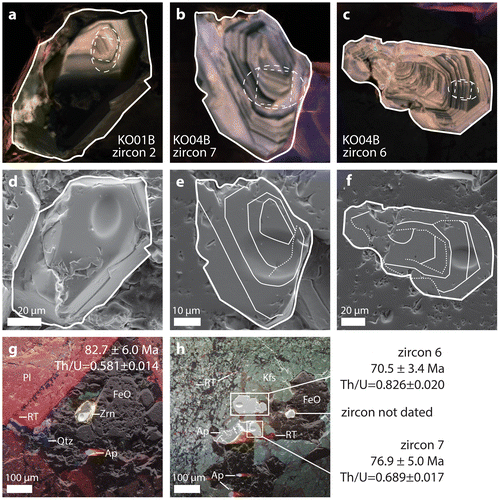
Zircon grains in Figure are also Late Cretaceous (76.8 ± 4.6–71.9 ± 3.3 Ma) and show remarkably similar patterns in their CL images. Each has a distinct dark core, an oscillatory-zoned mid-rim region, and anhedral, unzoned outer rim. The older zircon has a cracked core (Figure (a)) and its CL–SE image shows that it is hosted by plagioclase that has zones of darker red luminescence. The other zircon grains in this figure are hosted by or located near hornblende. Two spots on zircon 1 from sample KO02B (Figure (b)) differ in age by 4–18 m.y. The oldest spot (73.2 ± 4.0 Ma) is located on the mid-rim, whereas the younger spot (62.4 ± 3.1 Ma) may have sampled material from outside the grain boundary. The spot on the youngest zircon in this figure overlaps a microcrack shown by brighter orange CL and clearly seen in the SE image (Figure (c) and (f)).
Figure 9. CL images of dated (a) zircon 3 in sample KO01B, (b) zircon 1 in sample KO02B and (c) zircon 1 in sample KO03. Dashed white ovals outline the location of the ion microprobe spot and the solid line outlines the zircon grain. Two ages were obtained from zircon 1 in sample KO02B. (d), (e) and (f) are SE images of the dated zircons showing the elliptical depression made by the ion microprobe. Interpreted inner core, mid-rim and outer rim are outlined in white. Truncation surfaces are indicated with dashed curves. (g), (h) and (i) are composite CL–SE images of the zircon in thin section. Dark area above zircon 3 is a plucked grain.
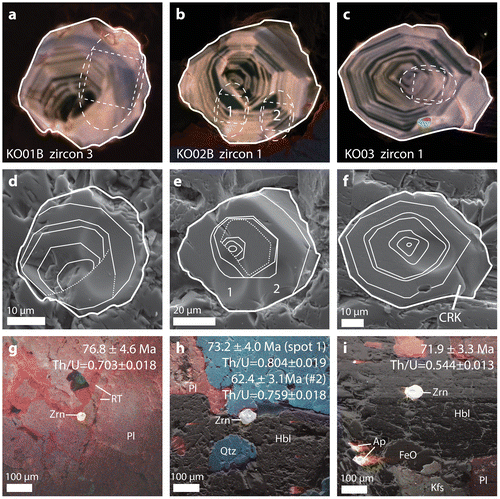
Both of the ion microprobe spots on the zircons in Figure overlap inclusions. It is unclear what the inclusions were, as they are plucked out of the grains. The 68.1 ± 3.0 Ma grain has 99.1 ± .3%206Pb*, but has a Th/U of 1.200 ± .208, suggesting the beam sampled a mineral with higher amounts of Th. The 70.2 ± 3.4 Ma grain has lower 206Pb* (93.7 ± 1.2%206Pb*), which may be due to the contribution of Pb from the inclusion. The composite CL–SE images of these samples show deformation textures seen in the other images, including bright red material that fills microcracks in K-feldspar and along grain boundaries. These zircons are found near or as inclusions in hornblende, a pattern common to the samples analyzed thus far.
Figure 10. CL images of dated (a) zircon 2 in sample KO03 and (b) zircon 3 in sample KO04B. Dashed white ovals outline the location of the ion microprobe spot and the solid line outlines the zircon grain. Inclusion depressions are observed as (a) light blue- and (b) brown- luminescing regions. (c) and (d) are SE images of the dated zircon showing the elliptical depression made by the ion microprobe. Interpreted inner core, mid-rim and outer rim are outlined in white. Truncation surfaces are indicated with dashed curves. (e) and (f) are composite CL–SE images of the zircons in thin section.

Figure shows the youngest granitoid zircons dated in the Beypazarı samples (66.6 ± 3.4 Ma, 51.5 ± 2.2 Ma). The spot on the older zircon overlaps a truncation surface. The zircon is between quartz and plagioclase (Figure (e)) and along this grain boundary plagioclase has a darker red hue. The ion microprobe beam appears to have mottled the zoning of the younger zircon. The grain is located between plagioclase and an iron oxide phase (Figure (f)), and the entire plagioclase grain is a dark reddish color.
Figure 11. CL images of dated (a) zircon 6 in sample KO01B and (b) zircon 4 in sample KO02B. Dashed white ovals outline the location of the ion microprobe spot and the solid line outlines the zircon grain. (c) and (d) are SE images of the dated zircon showing the elliptical depression made by the ion microprobe. Interpreted inner core, mid-rim and outer rim are outlined in white. Truncation surfaces are indicated with dashed curves. (e) and (f) are composite CL–SE images of the zircon in thin section.
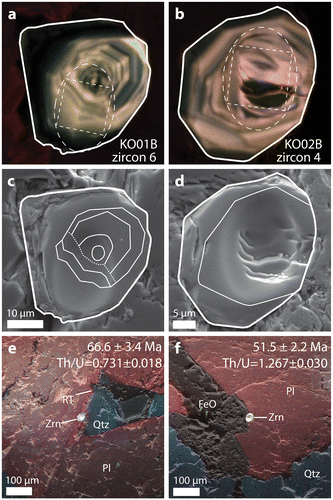
Two of the five dated zircons from aplite sample TA01B (zircons 3 and 5) were imaged in CL (Figure ). Both lack oscillatory zoning and only faint, dark green-emitting internal structures are observed (Figure (a) and (b)). Featureless or cloudy textures are characteristic of metamorphic or chemically altered zircon, whereas spongy textures are associated with hydrothermally precipitated zircon (Corfu et al., Citation2003; Hanchar & Rudnick, Citation1995). In SE images, no spongy (hydrothermal) texture is observed, but the grains show highly fractured and irregular surface topography (Figure (c) and (d)). Evidence of strain is observed in undulatory extinction of some quartz grains, and significant alteration in CL is observed in the mineral assemblage (Figure (e) and (f)).
Figure 12. CL images of dated (a) zircon 5 and (b) zircon 3 in sample TA01B. Three ages were obtained from grain 5. Dashed white ovals outline the location of the ion microprobe spots. (c) and (d) are SE images of the dated zircon with the dashed ovals indicated. e and f are composite CL–SE images of the zircons in thin section. (e) Zircon is located in the white box. (f) Zircon is outlined in white.
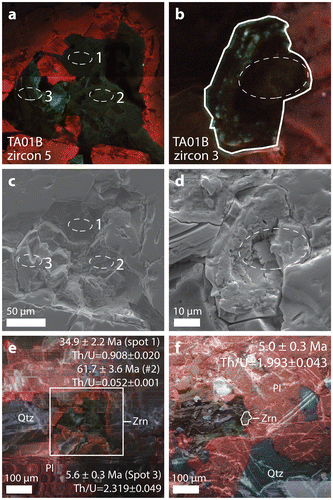
5. Discussion
5.1. Petrogenesis
The Beypazarı granitoid has been described as the product of subduction-related magmatism in a volcanic arc (Billur, Citation2004; Kadıoğlu & Zoroğlu, Citation2008; Yücel Öztürk et al., Citation2012). The pluton is a high-K, metaluminous, calc-alkaline, I-type granitoid, similar to granitoids found in active continental margins. Initial 87Sr/86Sr (.70529–.70704) and 143Nd/144Nd (.512257–.512437) ratios are reported for the pluton (Yücel Öztürk et al., Citation2012). These attributes, combined with geochemical data, suggest that fluid-flux melting of the mantle wedge above subducting oceanic lithosphere provided both heat and material to the base of the crust. These melts were modified by partial melting and mixing of heterogeneous continental crust during ascent and shallow emplacement in the Sakarya Zone.
Samples in this study were collected from the northern exposure of the pluton and are granite, granodiorite and quartz monzonite (Figure (a)). The wide range of compositions in the pluton, from gabbroic diorite to quartz monzonite, is incompatible with simple magmatic differentiation from a single parental melt. K and Rb increase with SiO2 content, whereas Fe2O3, MgO, CaO and TiO2 decrease, suggesting that fractional crystallization and/or partial melting contributed to the evolution of the magma.
Previous studies report that the pluton is magnesian, metaluminous and calc-alkalic. In contrast, our granitoid samples are ferroan, metaluminous and either calc-alkalic or alkali-calcic (Figure (b) through (d)). The aplite dike is ferroan, peraluminous and calc-alkalic. Whereas ferroan granitoids are associated with anhydrous melts under reducing conditions (Frost et al., Citation2001; Frost & Frost, Citation2008), recent studies suggest that ferroan metaluminous granitoids of intermediate composition may result from a combination of processes in various tectonic settings (Bogaerts et al., Citation2006; Frost & Frost, Citation2011). Assemblages ranging from ferroan to magnesian, and calc-alkalic to alkali-calcic, and the mafic enclaves analyzed in previous studies provide evidence of magma mixing (Billur, Citation2004; Frost & Frost, Citation2008; Kadıoğlu & Zoroğlu, Citation2008; Zoroğlu & Kadıoğlu, Citation2003).
Although trace-element composition is a function of the protolith and may not confirm a specific tectonic environment (Rollinson, Citation1993), our analyses show that the granitoid samples are consistent with those formed in volcanic arc intrusive settings (e.g. Figure (b)). Chondrite-normalized REE and multi-element patterns are compatible with derivation from a subduction-modified mantle source with significant crustal contribution (Figure (c) and (d)). The granitoid samples are enriched in LREE compared to HREE, and LILE are decoupled from HFSE with a significant Ta-trough that is characteristic of subduction zone magmatism (Rollinson, Citation1993).
Aplite sample TA01B may have been derived from residual granitoid melts. Light REE are incompatible in mafic minerals but behave as compatible elements in felsic magmas, thus the REE patterns of late-stage aplites are depleted with respect to the parent melt (Hanson, Citation1980; Miller & Mittlefehldt, Citation1982). With the exception of La, TA01B is depleted in REE compared to the granitoid rocks. Its U-shaped REE pattern reflects the affinity of accessory minerals, such as titanite and apatite, for light and middle REE in felsic rocks (Miller & Mittlefehldt, Citation1982; Glazner, Coleman & Bartley, Citation2008).
5.2. Age interpretations
The Beypazarı granitoid records crystallization over a ~20 m.y. span during the Late Cretaceous (95.4 ± 4.2–70.5 ± 3.4 Ma) and most ages are concordant within analytical uncertainty (Figure ). The pluton likely evolved in response to a number of processes over time. Periodic injection and mixing with hot mafic magma can explain the range of Late Cretaceous zircon ages. Magma mixing would juxtapose zircons with ages that vary within 8–32 m.y., depending on uncertainty. Additional heat would also account for thermal perturbations that extended the duration of crystallization.
The CL images show that the granitoid zircons record zoning consistent with primary igneous crystallization (Figures through ). Most contain distinct cores, mid-rim regions often with oscillatory zoning and overprinted sector zones, and flat outer rims. These characteristics are attributed to igneous growth in variable melt compositions (Connelly, Citation2000; Hanchar & Miller, Citation1993; Marshall, Citation1988).
Our oldest age (95.4 ± 4.2 Ma), which includes the zircon core, is our best estimate for initial crystallization (Figure (a)). It is possible that the oldest zircons are xenocrysts assimilated from another source; however, the Tepeköy metamorphic unit into which the pluton intruded may be of Triassic age (Sayıt & Göncüoğlu, Citation2013) and, presumably, deeper units are even older. Alternatively, the zircons crystallized during ascent of the parental melts through the crust. Zircon is more soluble in mafic magmas than in felsic melts (Watson & Harrison, Citation1983) and would precipitate as the rising melts evolved. U–Pb ages of zircons from the mafic enclaves could help to evaluate this hypothesis.
Ages obtained from zircon mid-rims (82.7 ± 6.0–70.5 ± 3.4 Ma) likely time continuous crystallization of zircon during the Late Cretaceous (Figures and ). These overlap with ages from the GAC and the Sivrihisar granitoid. The younger granitoid ages (70.2 ± 3.4–51.5 ± 2.2 Ma) (Figures and ) overlap inclusions or show evidence of alteration in CL, suggesting they were affected by subsequent metamorphic processes, and are excluded because they do not represent crystallization of the pluton.
The majority of dated aplite zircons contain low radiogenic Pb, have non-igneous Th/U values, and/or fall outside the range of their analytical calibration curve. The two concordant Pliocene ages may be meaningless due to problems in analyzing altered grains. Alternatively, these ages may record a disturbance due to a change in tectonic regime during the Pliocene. The CL images of the sample provide evidence of metamorphism or fluid-driven alteration rather than crystallization (Figure ) (Hoskin & Schaltegger, Citation2003; Watson, Cherniak, Hanchar, Harrison & Wark, Citation1997). Late Miocene–Early Pliocene volcanism occurred in the nearby GAC (Keller et al., Citation1992; Koçyiğit et al., Citation2003), and present-day evidence for extension and fault-driven fluid-rock interaction in the southwest Beypazarı granitoid are represented by the Kapullu Bath Spring, a deeply circulating geothermal feature characterized by normal faults (Diker et al., Citation2006).
The aplite zircon grains have highly fractured morphologies that serve as conduits for fluid infiltration (Connelly, Citation2000; Corfu et al., Citation2003; Rubin, Henry & Price, Citation1993; Watson et al., Citation1997). Zircon is more susceptible to alteration in alkaline fluids (Rubin et al., Citation1993). Fluids from the alkalic metamorphic rocks into which the pluton intruded (Göncüoğlu et al., Citation2000), or perhaps an even deeper source, may have caused high-temperature circulation to alter the sample. Some of the granitoid CL images also show evidence of alteration along grain boundaries, and we account for that in our interpretation of crystallization ages. The aplite CL is more affected by alteration or metamorphism, likely because the dikes are located in zones of inherent weakness. Further analyses of the aplite dikes are needed to characterize their age and document the degree of alteration/metamorphism.
Located south of the field area, the Sivrihisar granitoid intruded HP/LT metamorphic assemblages of the subducting Tavşanlı Zone (e.g. Okay et al., Citation1998). This pluton is also characterized by two populations of zircon with U–Pb ages ranging from Late Cretaceous to Eocene (Shin et al., Citation2013). Whereas the Late Cretaceous–Paleocene ages (78.4 ± 4.2–64.9 ± 6.4 Ma) may represent the early stages of crystallization or assimilated zircons from previously crystallized granitic basement or HP/LT assemblages, the Eocene ages (48.9 ± 4.5–42.4 ± 2.3 Ma) are interpreted to time crystallization of the Sivrihisar granitoid (Shin et al., Citation2013).
The geographic proximity of the Beypazarı granitoid to the GAC and the Sivrihisar granitoid suggests that these igneous systems may be related by processes that occurred during closure of the Neo-Tethys Ocean (Catlos, Shin, Speciale, Yıldız, & Black, Citation2012; Shin et al., Citation2013). The subducting Tavşanlı slab was likely the source of mantle melts that induced the parental magmas of the Beypazarı granitoid and the GAC, which has been interpreted as the back-arc of a supra-subduction zone setting (Koçyiğit et al., Citation2003). A possible reason for the overlap in Late Cretaceous ages is concurrent magmatism from a similar source in response to rollback of the subducting Tavşanlı slab, which could also account for back-arc extension in the GAC (Koçyiğit et al., Citation2003). Alternatively, the Late Cretaceous zircons in the Sivrihisar granitoid may be related to exhumation of the HP/LT assemblages and were entrained in the rising melts during intrusion of the granitoid.
5.3. Model
Figure presents a model of the interpreted geodynamic evolution of the Beypazarı granitoid. The Beypazarı granitoid and adjacent GAC are located in the overriding continental plate of a north-dipping subduction complex. The Tavşanlı and Afyon Zones represent fragments of the Cimmerian Continent which collide to form parts of the Anatolide–Tauride Block (Göncüoğlu et al., Citation2000; Moix et al., Citation2008; Okay & Tüysüz, Citation1999; Şengör, Citation1979; Şengör & Yılmaz, Citation1981). The marginal ocean basins that separate these continental fragments correspond to northern and southern branches of the Neo-Tethys.
Figure 13. Tectonic evolution model showing the interpreted geodynamic history of the Beypazarı granitoid and its relationship to the GAC and Sivrihisar granitoid. The subduction zone diagram is adapted from Cloos et al. (Citation2005). (a) From ~95–85 Ma, dehydration of subducting Tavşanlı oceanic crust hydrates the mantle wedge and induces crustal melting in the Sakarya Zone. HP/LT assemblages develop in the Tavşanlı Zone, and subduction is initiated in the Afyon Zone. (b) Between ~85–70 Ma Beypazarı melts evolve, and volcanism occurs in the GAC. The Tavşanlı Zone is exhumed, and the subducting Afyon slab weakens the Tavşanlı slab. (c) The Tavşanlı Zone transitions from subduction to collision and the slab breaks off by the Eocene. The Sivrihisar granitoid intrudes the HP/LT Tavşanlı Zone. Development of the İAESZ occurs, ending subduction magmatism and culminating in an Eocene orogeny. See Section 5.3 for further discussion.
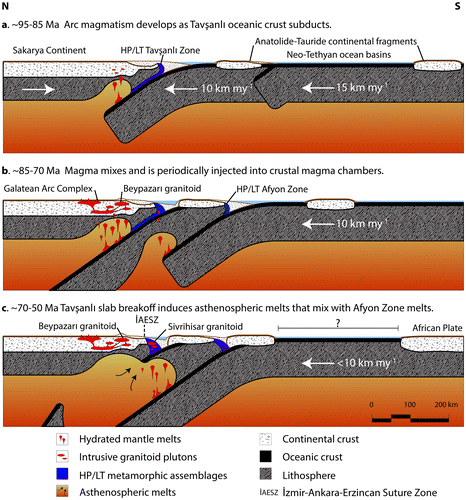
Figure (a) shows development of arc magmatism in the Sakarya Zone during the Late Cretaceous (~95–85 Ma). Dehydration of the subducting Tavşanlı slab induces fluid-flux melting of the mantle wedge. Mantle melts add heat and material to the base of the lithosphere and induce partial melting of the crust. During ascent of the buoyant magma, zircon begins to crystallize as the melts differentiate. The oldest zircon ages (95.4 ± 4.2–91.3 ± 6.5 Ma) time initial crystallization of the Beypazarı granitoid. Alternatively, these ages may represent zircons from previously crystallized basement assemblages that were entrained in the rising melts. To the south, marginal Neo-Tethys ocean basins separate the Sakarya Zone from fragments of the Anatolide–Tauride Block (e.g. Şengör & Yılmaz, Citation1981). HP/LT assemblages develop in the Tavşanlı Zone (Okay et al., Citation1996; Okay & Tüysüz, Citation1999; Sherlock, Kelley, Inger, Harris & Okay, Citation1999; Whitney, Teyssier, Toraman, Seaton, & Fayon, Citation2011) in response to the partial subduction of continental crust to depths of 70–80 km (Okay & Satır, Citation2006; Whitney et al., Citation2011). Closure of the southern branch of the Neo-Tethys in this region is initiated by subduction of the HP/LT Afyon Zone (Shin et al., Citation2013), possibly due to development of a zone of weakness in the oceanic lithosphere or differential rates of plate motion (e.g. Cloos, Citation1993).
In Figure (b), arc magma continues to access conduits that supply melts to the Beypazarı pluton, as recorded by mid-rim zircon ages (82.7 ± 6.0–70.5 ± 3.4 Ma). Volcanism in the GAC is reported during this time (K-Ar hornblende, 76 ± 2.4–73.2 ± 1.2 Ma) (Keller et al., Citation1992; Koçyiğit et al., Citation2003). Based on geochemical similarities between the Beypazarı granitoid and the GAC, the coeval melts may originate from a similar source. Hot mafic magma is periodically injected into crustal magma chambers and mixes with more felsic melts to produce the mafic enclaves (Kadıoğlu & Zoroğlu, Citation2008) and geochemical heterogeneities within the Beypazarı granitoid. These thermal perturbations result in continuous zircon crystallization until ~70 Ma.
A sharp decline in the rate of convergence during the latest Cretaceous suggests that closure of the northern branch of the Neo-Tethys is slowing as the buoyant continental landmass resists further subduction (Okay & Satır, Citation2006). Blueschist detritus observed in Late Cretaceous flysch deposits is consistent with partial exhumation of the Tavşanlı Zone by the end of the Cretaceous (Okay et al., Citation1998). The Afyon Zone lithosphere achieves the depths that initiate slab dehydration (Shin et al., Citation2013) and experiences blueschist-facies metamorphism to a depth of ~35 km during the Late Cretaceous–Early Tertiary (Candan et al., Citation2005). Fluid-flux melting of the mantle wedge above the Afyon slab weakens and thins the base of the Tavşanlı lithosphere.
In Figure (c), the Tavşanlı continental margin transitions from subduction to collision with the Sakarya Zone during the Late Cretaceous–Paleocene (e.g. Okay & Satır, Citation2006). The weakened Tavşanlı slab breaks off by the Eocene, giving rise to magma mixing of (1) decompression melts that underplate a metasomatized and hydrated layer; and (2) Afyon subduction zone-generated melts (Shin et al., Citation2013). The Late Cretaceous–Paleocene ages of the Sivrihisar granitoid are attributed to extended crystallization, assimilation of zircons from previously crystallized granitic basement (Shin et al., Citation2013), or entrainment of zircons possibly related to exhumation of the HP/LT assemblages into which the pluton intruded. The Sivrihisar pluton crystallized primarily during the Eocene, and is part of a roughly linear NW/SE-trending magmatic belt attributed to post-collisional slab breakoff or lithospheric delamination (Altunkaynak, Citation2007; Altunkaynak & Dilek, Citation2013; Dilek & Altunkaynak, Citation2009; Dilek & Sandvol, Citation2009; Shin et al., Citation2013). Recent teleseismic Pn velocity, Sn attenuation, and P-wave travel time tomography models show fast seismic anomalies near the 660 km discontinuity beneath the Sakarya, Tavşanlı and Afyon Zones, interpreted as possible remnants of detached Tethyan slab(s) or delaminated lithosphere (Biryol, Beck, Zandt & Özacar, Citation2011; Dilek and Sandvol, Citation2009).
Mantle upwelling through an asthenospheric window caused by slab breakoff is evidenced by a linear distribution of plutons, bi-modal (mafic and felsic) magmatism and a restricted range of crystallization ages (~5 m.y.) (von Blanckenburg & Davies, Citation1995). The Eocene plutonic belt in northwest Turkey represents 20 m.y. of melt generation (~54–34 Ma) and straddles the İAESZ (Okay & Satır, Citation2006; Ustaömer et al., Citation2009), suggesting that slab breakoff may not be the only process contributing to the development of these granitoids. A second, NE-dipping subduction zone south of the Tavşanlı Zone has been previously suggested as a possible source for the Eocene granitoids in the region (Harris, Kelley & Okay, Citation1994; Okay & Satır, Citation2006; Shin et al., Citation2013). In our model, a combination of processes, including Tavşanlı slab breakoff and Afyon slab subduction, is the cause of syn-collisional granitic magmas that led to intrusion of the Sivrihisar granitoid into the exhumed HP/LT rocks of the Tavşanlı Zone.
Acknowledgments
This material is based upon work supported by the National Science Foundation under Grant No. 0937254. Additional funding was provided by The University of Texas Undergraduate Research Fellowship and the Jackson School of Geosciences. Samples were obtained with the help of Şükrü Gökhan Köse, Jessica Magers and Nilay Yağcıoğlu. Comments from Drs. Mark Helper, Jaime Barnes, Mark Cloos, Ş. Can Genç, Erdin Bozkurt and an anonymous reviewer greatly improved the original manuscript. The authors thank the UCLA National Ion Microprobe Facility (particularly Drs Rita Economos and Axel Schmitt), which is partially supported by funding from the National Science Foundation’s Instrumentation and Facilities Program. Ages were obtained with the help of Kathryn Huber. CL imagery was generated with the support of The University of Texas Bureau of Economic Geology. Some figures were drafted with the assistance of Chris Macon. We appreciate discussions with Michael Prior and analytical assistance by Toti Larsen and Rob Reed.
References
- Altunkaynak, Ş. (2007). Collision-driven slab breakoff magmatism in Northwestern Anatolia, Turkey. The Journal of Geology, 115, 63–82.
- Altunkaynak, Ş., & Dilek, Y. (2013). Eocene mafic volcanism in northern Anatolia: Its causes and mantle sources in the absence of active subduction. International Geology Review, 1. doi:10.1080/00206814.2013.792497
- Billur, B. (2004). Geology and petrology of the Beypazarı Granitoids: Yassikaya sector (Unpublished master’s thesis). Middle East Technical University, Turkey.
- Bogaerts, M., Scaillet, B., & Auwera, J. V. (2006). Phase Equilibria of the Lyngdal Granodiorite (Norway): Implications for the origin of Metaluminous Ferroan Granitoids. Journal of Petrology, 47, 2405–2431.
- Biryol, C. B., Beck, S. L., Zandt, G., & Özacar, A. (2011). Segmented African lithosphere beneath the Anatolian region inferred from teleseismic P-wave tomography. Geophysical Journal International, 184, 1037–1057.
- Candan, O., Çetinkaplan, M., Oberhänsli, R., Rimmelé, G., & Akal, C. (2005). Alpine high-P/low-T metamorphism of the Afyon zone and implications for the metamorphic evolution of Western Anatolia, Turkey. Lithos, 84, 102–124.
- Catlos, E. J., Gilley, L. D., & Harrison, T. M. (2002). Interpretation of monazite ages obtained via in situ analysis. Chemical Geology, 188, 193–215.
- Catlos, E. J., Jacob, L., Oyman, T., & Sorensen, S. (2012). Long-term exhumation of Aegean metamorphic core complex granitoids in the northern Menderes Massif, western Turkey. American Journal of Science, 312, 534–571.
- Catlos, E. J., Shin, T. A., Speciale, P., Yıldiz, G. O., & Black, K. (2012). Linked magmatic events in central Turkey: Geochemistry and geochronology of the Beypazarı and Sivrihisar granitoids. Geophysical Research Abstract, EGU General Assembly.
- Cavosie, A. J., Wilde, S. A., Liu, D., Weiblen, P. W., & Valley, J. W. (2004). Internal zoning and U-Th-Pb chemistry of Jack Hills detrital zircons: A mineral record of early Archean to Mesoproterozoic (4348-1576 Ma) magmatism. Precambrian Research, 135, 251–279.
- Chappell, B. W., & White, A. J. R. (1974). Two contrasting granite types. Pacific Geology, 8, 173–174.
- Cloos, M. (1993). Lithospheric buoyancy and collisional orogenesis: Subduction of oceanic plateaus, continental margins, island arcs, spreading ridges, and seamounts. Geological Society of America Bulletin, 105, 715–737.
- Cloos, M., Sapiie, B., van Ufford, A. Q., Weiland, R. J., Warren, P. Q., & McMahon, T. P. (2005). Collisional delamination in New Guinea: The geotectonics of subducting slab breakoff. Geological Society of America Special Paper 400.
- Connelly, J. (2000). Degree of preservation of igneous zonation in zircon as a signpost for concordancy in U/Pb geochronology. Chemical Geology, 172, 25–39.
- Corfu, F., Hanchar, J. M., Hoskin, P. W. O., & Kinny, P. (2003). Atlas of zircon textures. Reviews in Mineralogy and Geochemistry, 53/1, 469–500.
- Delaloye, M., & Bingöl, E. (2000). Granitoids from Western and Northwestern Anatolia: Geochemistry and modeling of geodynamic evolution. International Geology Review, 42, 241–268.
- Diker, S., Çelik, M., & Kadıoğlu, Y. (2006). Finger prints of the formation of geothermal springs on the granitoids: Beypazarı-Ankara, Turkey. Environmental Geology, 51, 365–375.
- Dilek, Y., & Altunkaynak, Ş. (2009). Geochemical and temporal evolution of Cenozoic magmatism in western Turkey: Mantle response to collision, slab break-off, and lithospheric tearing in an orogenic belt (pp. 213–233). London: Geological Society, Special Publications 311.
- Dilek, Y., & Sandvol, E. (2009). Seismic structure, crustal architecture and tectonic evolution of the Anatolian-African plate boundary and the Cenozoic Orogenic Belts in the Eastern Mediterranean region. In J. B. Murphy, J. D. Keppie, & A. J. Hynes (Eds.), Ancient orogens and modern analogues (pp. 127–160). London: Geological Society, Special Publications 327.
- Dowty, E. (1976). Crystal structure and crystal growth: II. Sector zoning in minerals. American Mineralogist, 61, 460–469.
- Faure, G. (1986). Principles of isotope geology. New York, NY: Wiley.
- Finch, A. A., & Klein, J. (1999). The causes and petrological significance of cathodoluminescence emissions from alkali feldspars. Contributions to Mineralogy and Petrology, 135, 234–243.
- Frost, B., Barnes, C. G., Collins, W. J., Arculus, R. J., Ellis, J. D., & Frost, C. D. (2001). A geochemical classification for granitic rocks. Journal of Petrology, 42, 2033–2048.
- Frost, B. R., & Frost, C. D. (2008). A geochemical classification for feldspathic igneous rocks. Journal of Petrology, 49, 1955–1969.
- Frost, C. D., & Frost, B. R. (2011). On ferroan (A-type) granitoids: Their compositional variability and modes of origin. Journal of Petrology, 52, 39–53.
- Glazner, A. F., Coleman, D. S., & Bartley, J. M. (2008). The tenuous connection between high-silica rhyolites and granodiorite plutons. Geology, 36, 183–186.
- Göncüoğlu, M. C., Turhan, N., Şentürk, K., Özcan, A., Uysal, Ş., & Yalınız, M. K. (2000). A geotraverse across northwestern Turkey: Tectonic units of the Central Sakarya region and their tectonic evolution. In E. Bozkurt, J. A. Winchester, & J. D. A. Piper (Eds.), Tectonics and magmatism in Turkey and the surrounding area (pp. 139–161). London: Geological Society, Special Publications 173.
- Hanchar, J., & Miller, C. (1993). Zircon zonation patterns as revealed by cathodoluminescence and backscattered electron images: implications for interpretation of complex crustal histories. Chemical Geology, 110, 1–13.
- Hanchar, J., & Rudnick, R. (1995). Revealing hidden structures: The application of cathodoluminescence and back-scattered electron imaging to dating zircons from lower crustal xenoliths. Lithos, 36, 289–303.
- Hanson, G. N. (1980). Rare Earth Elements in Petrogenetic Studies of Igneous Systems. Annual Review of Earth and Planetary Sciences, 8, 371–406.
- Harris, N. B. W., Kelley, S., & Okay, A. I. (1994). Post-collision magmatism and tectonics in northwest Anatolia. Contributions to Mineralogy and Petrology, 117, 241–252.
- Helvacı, C., & Bozkurt, S. (1994). Geology, mineralogy and petrogenesis of Beypazarı (Ankara) granite. Geological Bulletin of Turkey, 37, 31–42 [in Turkish with English abstract].
- Hoskin, P. W. O., & Schaltegger, U. (2003). The composition of Zircon and Igneous and Metamorphic Petrogenesis. Reviews in Mineralogy and Geochemistry, 53/1, 27–62.
- Ju, G., Hu, Y., Chen, L., & Wang, X. (2012). Persistent luminescence and its mechanism of Ba5(PO4)3Cl:Ce3+Eu2+. Journal of Applied Physics, 111, 113508. doi:10.1063/1.4723646
- Kadıoğlu, Y. K., & Zoroğlu, O. (2008). Nature of Beypazarı Granitoid: Geology and geochemistry, Northwest Anatolia, Turkey. IOP Conference Series: Earth and Environmental Science, Bristol, UK 2, 012014.
- Keller, J., Jung, D., Eckhardt, F.-J., & Kreuzer, H. (1992). Radiometric ages and chemical characterization of the Galatean andesite massif, Pontus, Turkey. Acta Vulcanologica, 2, 267–276.
- Koçyiğit, A., Winchester, J. A., Bozkurt, E., & Holland, G. (2003). Saraçköy Volcanic Suite: Implications for the subductional phase of arc evolution in the Galatean Arc Complex, Ankara, Turkey. Geological Journal, 38, 1–14.
- Kretz, R. (1983). Symbols for rock-forming minerals. American Mineralogist, 68, 277–279.
- Marshall, D. J. (1988). Cathodoluminescence of geological materials. Boston: Unwin, Hyman.
- Middlemost, E. A. K. (1994). Naming minerals in the magma/igneous rock system. Earth-Science Reviews, 37, 215–224.
- Miller, C. F., & Mittlefehldt, D. W. (1982). Depletion of light rare-earth elements in felsic magmas. Geology, 10, 129–133.
- Moix, P., Beccaletto, L., Kozur, H. W., Hochard, C., Rosselet, F., & Stampfli, G. M. (2008). A new classification of the Turkish terranes and sutures and its implication for the paleotectonic history of the region. Tectonophysics, 451, 7–39.
- Okay, A. I. (2008). Geology of Turkey: A synopsis. Anschnitt, 21, 19–42.
- Okay, A. I., Harris, N. B. W., & Kelley, S. P. (1998). Exhumation of blueschists along a Tethyan suture in northwest Turkey. Tectonophysics, 285, 275–299.
- Okay, A., & Satır, M. (2006). Geochronology of Eocene plutonism and metamorphism in northest Turkey: evidence for a possible magmatic arc. Geodinamica Acta, 19, 251–266.
- Okay, A., Satır, M., Maluski, H., Siyako, M., Monie, P., Metzger, R., & Akyüz, S. (1996). Paleo- and Neo-Tethyan events in northwestern Turkey: Geologic and geochronologic constraints. In A. Yin, & T. M. Harrison (Eds.), The tectonic evolution of Asia (pp. 420–441). Cambridge: Cambridge University Press.
- Okay, A. I., & Tüysüz, O. (1999). Tethyan sutures of northern Turkey. In B. Durand, L. Jolivet, F. Horváth, & M. Séranne (Eds.), The mediterranean basins: Tertiary extension within the alpine orogen (pp. 475–515). London: Geological Society, Special Publications 156.
- Özsayin, E., & Dirik, K. (2007). Quaternary activity of the Cihanbeyli and Yeniceoba Fault Zones: İnönü-Eskişehir fault system, Central Anatolia. Turkish Journal of Earth Science, 16, 471–492.
- Pearce, J. A., Harris, N. B. W., & Tindle, A. G. (1984). Trace element discrimination diagrams for the tectonic interpretation of granitic rocks. Journal of Petrology, 25, 956–983.
- Peccerillo, A., & Taylor, S. R. (1976). Geochemistry of Eocene calc-alkaline volcanic rocks from the Kastamonu Area, Northern Turkey. Contributions to Mineralogy and Petrology, 58, 63–81.
- Rollinson, H. R. (1993). Using geochemical data: Evaluation, presentation, interpretation. Suffolk: Pearson Prentice Hall.
- Rubin, J. N., Henry, C. D., & Price, J. G. (1993). The mobility of zirconium and other “immobile” elements during hydrothermal alteration. Chemical Geology, 110, 29–47.
- Sayıt, K., & Göncüoğlu, M. C. (2013). Geodynamic evolution of the Karakaya Mélange Complex, Turkey: A review of geological and petrological constraints. Journal of Geodynamics, 65, 56–65.
- Schneider, D. A., Edwards, M. A., Kidd, W. S. F., Zeitler, P. K., & Coath, C. D. (1999). Early Miocene anatexis identified in the western syntaxis, Pakistan Himalaya. Earth and Planetary Science Letters, 167, 121–129.
- Şenel, M., & Aydal, N. (2002). Geologic map of Turkey (Ankara sheet). Eskişehir Yolu, Turkey: Maden Tetkik ve Arama Genel Müdürlüğü.
- Şengör, A. M. C. (1979). Mid-Mesozoic closure of Permo-Triassic Tethys and its implications. Nature, 279, 590–593.
- Şengör, A. M. C., & Yılmaz, Y. (1981). Tethyan evolution of Turkey: A plate tectonic approach. Tectonophysics, 75, 181–241.
- Sherlock, S., Kelley, S., Inger, S., Harris, N., & Okay, A. (1999). 40Ar-39Ar and Rb-Sr geochronology of high-pressure metamorphism and exhumation history of the Tavşanlı Zone, NW Turkey. Contributions to Mineralogy and Petrology, 137, 46–58.
- Shin, T. A., Catlos, E. J., Jacob, L., & Black, K. (2013). Relationships between very high pressure subduction complex assemblages and intrusive granitoids in the Tavşanlı Zone, Sivrihisar Massif, central Anatolia. Tectonophysics, 595–596, 183–197.
- Shtukenberg, A. G., Punin, Y. O., & Artamonova, O. I. (2009). Effect of crystal composition and growth rate on sector zoning in solid solutions grown from aqueous solutions. Mineralogical Magazine, 73, 385–398.
- Steiger, R. H., & Jäger, E. (1977). Subcommission on geochronology: Convention on the use of decay constants in geo- and cosmochronology. Earth and Planetary Science Letters, 36, 359–362.
- Sun, S. -S., & McDonough, W. F. (1989). Chemical and isotopic systematics of oceanic basalts: implications for mantle composition and processes. In A. D. Saunders, & M. J. Norry (Eds.), Magmatism in the Ocean Basins (pp. 313–345). London: Geological Society, Special Publications 42.
- Ustaömer, P. A., Ustaömer, T., Collins, A. S., & Reischpeitsch, J. (2009). Lutetian arc-type magmatism along the southern Eurasian margin: New U-Pb LA-ICPMS and whole-rock geochemical data from Marmara Island, NW Turkey. Mineralogy and Petrology, 96, 177–196.
- Vavra, G., Gebauer, D., Schmid, R., & Compston, W. (1996). Multiple zircon growth and recrystallization during polyphase Late Carboniferous to Triassic metamorphism in granulites of the Ivrea Zone (Southern Alps): An ion microprobe (SHRIMP) study. Contributions to Mineralogy and Petrology, 122, 337–358.
- von Blanckenburg, F., & Davies, J. H. (1995). Slab breakoff: A model for syncollisional magmatism and tectonics in the Alps. Tectonics, 14, 120–131.
- Watson, E. B., Cherniak, D. J., Hanchar, J. M., Harrison, T. M., & Wark, D. A. (1997). The incorporation of Pb into zircon. Chemical Geology, 141, 19–31.
- Watson, E. B., & Harrison, T. M. (1983). Zircon saturation revisited: Temperature and composition effects in a variety of crustal magma types. Earth and Planetary Science Letters, 64, 295–304.
- Whitney, D. L., Teyssier, C., Toraman, E., Seaton, N. C. A., & Fayon, A. K. (2011). Metamorphic and tectonic evolution of a structurally continuous blueschist-to-Barrovian terrane, Sivrihisar Massif, Turkey. Journal of Metamorphic Geology, 29, 193–212.
- Wiedenbeck, M., Allé, P., Corfu, F., Griffin, W. L., Meier, M., Oberli, F., Von Quadt, A., Roddick, J. C., & Spiegel, W. (1995). Three natural zircon standards for U-Th-Pb, Lu-Hf, trace-element and REE analyses. Geostandards Newsletter, 19, 1–23.
- Williams, I. S., & Claesson, S. (1987). Isotopic evidence for the Precambrian provenance and Caledonian metamorphism of high grade paragneisses from the Seve Nappes, Scandinavian Caledonides: II. Ion microprobe zircon U-Th-Pb. Contributions to Mineralogy and Petrology, 97, 205–217.
- Yağmurlu, F., & Helvacı, C. (1994). Sedimentological characteristics and facies of the evaporite-bearing Kirmir Formation (Neogene), Beypazarı Basin, central Anatolia, Turkey. Sedimentology, 41, 847–860.
- Yücel Öztürk, Y., Helvacı, C., & Satır, M. (2012). Geochemical and isotopic constraints on petrogenesis of the Beypazarı Granitoid, NW Ankara, Western Central Anatolia, Turkey. Turkish Journal of Earth Sciences, 21, 53–77.
- Zoroğlu, O., & Kadıoğlu, Y. K. (2003). Oymaağaç (Beypazarı-Ankara) Granitoyidinin Jeolojisi ve Petrografisi [Oymaağaç (Beypazarı-Ankara) Granitoid geology and petrography]. Gazi University Journal of Science, 16/2, 299–308. [in Turkish with English abstract].
Appendix 1
Each zircon was confirmed with back-scattered electrons (BSE) and energy-dispersive X-ray spectrometry (EDS) using the JEOL 8200 electron microprobe at UT Austin, Jackson School of Geosciences. The microprobe operated at standard conditions with an accelerating voltage of 15 kV, spot size of 60 and working distance of 10 mm. As the sample is bombarded with electrons, heavy elements (e.g. U and Th) in the zircon crystal lattice eject X-rays of greater intensity than surrounding minerals, enabling detection of zircon by its brilliant white color in BSE images (Hanchar & Miller, Citation1993). After EDS zircon determination, the chips were mounted with polished blocks of zircon age standards (AS3, 1099 ± 1 Ma) (Schneider, Edwards, Kidd, Zeitler, & Coath, Citation1999). Ages were determined during two separate analytical sessions. For sample TA01B, the ion microprobe operated with a mass resolution of 4800, primary accelerating voltage –12.5 kV, secondary voltage ~10 kV, arc current ~74.7–74.9 mA and aperture window ~15 × 15 μm. Similar operating conditions were employed for analyses of granitoid samples. In both cases, an aperture window was utilized to minimize collection of secondary ions from outside the zircon grain. In a typical 15-min analysis, secondary ions extracted from the zircon surface leave a ~30-μm elliptical pit as little as ~10Å in depth.
To calculate unknown zircon ages, the standard age Equation (Equation1(1) ) was used:
(1)
where t = age (Ma), λ is the decay constant for 238U (assumed to be 1.55125 × 10−4 Ma−1) (Steiger & Jäger, Citation1977) and (206Pb/238U)cal is corrected for instrument dead time, drift, common Pb and estimated relative to AS3 age standards. Common Pb corrections assume 206Pb/204Pb = 18.86, 207Pb/204Pb = 15.62 and 208Pb/204Pb = 38.34. Age uncertainties strongly depend on inter-element fractionation of U, Th and Pb, which is monitored using zircon standards. U–Pb sensitivity was calibrated as a function of UO+/U+. For granitoid samples, 44 spots on multiple grains of zircon standard AS3 were analyzed to develop the calibration curve that yields Equation (Equation2(2) ):
(2)
and reproduced the age of the AS3 standard to 1100 ± 62 Ma (±1σ). Twenty-four spots on AS3 were analyzed for aplite sample TA01B to derive the calibration curve (3):(3)
and reproduced the age of the AS3 standard to an average of 1103 ± 88 Ma.
To calculate Th/U ratios of the zircon grains (Tables and ), standard 91500 (Wiedenbeck et al., Citation1995) was analyzed and Equation (Equation4(4) ) was used:
(4)
where (Th/U)91500 is .35 (Wiedenbeck et al., Citation1995), (Th+/U+)91500m is measured in the standard grain (.2521 ± .006 for granitoid samples, and .3153 ± .007 for TA01B) and (Th+/U+)zircon is the measured ratio for each dated grain.
